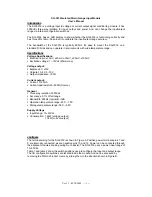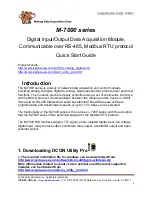
© National Instruments
|
2-1
2
NI 651
x
Features
This chapter describes the National Instruments digital I/O features available for NI 651
x
devices. For more information on the NI industrial DIO feature set, refer to the
Complete
Industrial Digital I/O and Counter/Timer Tutorial
. To access this tutorial, visit
ni.com/info
and enter the code
rdcidi
.
Digital Filtering
Use the digital filter option available on the NI 651
x
input lines to eliminate glitches on input
data. When used with change detection, filtering can also reduce the number of changes to
examine and process.
You can configure the digital input channels to pass through a digital filter after the
photocouplers, and you can control the timing interval the filter uses. The filter blocks pulses
that are shorter than half of the specified timing interval and passes pulses that are longer than
the specified interval. Intermediate-length pulses—pulses longer than half of the interval but less
than the interval—may or may not pass the filter.
The filter operates on the inputs from the photocouplers. Photocouplers turn on faster than they
turn off and pass rising edges faster than falling edges.
Table 2-1 lists the pulse widths guaranteed to be passed and blocked.
You can enable filtering on as many input lines as is necessary for your application. All filtered
lines share the same timing interval, which ranges from 200
s to 200 ms.
Internally, the filter uses two clocks: the sample clock and the filter clock. The sample clock has
a 100 ns period. The filter clock is generated by a counter and has a period equal to one half of
the specified timing interval. The input signal is sampled on each rising edge of the sample clock,
which is every 100 ns. However, a change in the input signal is recognized only if it maintains
its new state for at least two consecutive rising edges of the filter clock.
Table 2-1.
NI 651
x
Digital Filter Timing Intervals
Filter
Interval
Pulse Width Passed
Pulse Width Blocked
Low Pulse
High Pulse
Low Pulse
High Pulse
t
interval
t
interval
+ 200
s
t
interval
t
interval
/2
(t
interval
/2) – 200
s















































